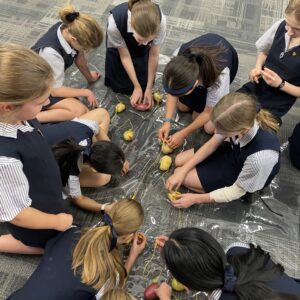
Science Week Celebrations Continue
As an extension of our Science Week celebrations, Mrs Mia Sharma, Science Teacher in the Secondary School, hosted a series of Science Shows for the girls in the Primary School. Starting with Kindergarten, Year 1 and Year 2, Mrs Sharma organised a range of hands-on activities for the girls to learn about static electricity. This included a soft-can race powered by static electricity and a balloon relay in which each team had to use static electricity to ‘attach’ as many balloons to a person in their team as possible. Mrs Sharma explained the science behind how static electricity works. She introduced the girls to atoms and explained that everything in our world is made of atoms. She then dived in deeper to explain that atoms are made up of even tinier particles called electrons. While we cannot see electrons with the human eye, we can see what happens to an object when electrons move. The girls created their own dragonflies and, by rubbing a balloon on the carpet, they created static electricity that then made the wings of their dragonfly flap.
Years 3 and 4 also learnt about static electricity and ventured a little further in their understanding of electrons. The girls learnt that a static charge is formed when two surfaces touch each other and the electrons move from one object to another. Mrs Sharma set up an experiment using the Van de Graaff Generator to demonstrate what happens when like charges of electrons repel each other. The result was some impressive new hairstyles as the force of the electrons made the girls’ hairs stand up and spread away from each other. Another experiment demonstrated what happens when opposite charges attract. They loved trying to ‘stick’ as many balloons as they could to their head by creating static electricity.
How can a potato power a light globe? Mrs Sharma proposed this challenge to the girls in Years 5 and 6. Using a potato, fork and electrode, the girls created a power source for a LED light. They learnt that the potato acts as a battery and conducts electricity by acting as a salt bridge between the fork and the electrode. Using their knowledge of electrical circuits, the girls created an impressive string of LED lights that decorated the Auditorium and were powered by the humble potato! Science is fascinating!
Thank you to Mrs Sharma for organising these amazing Science Shows for our girls in the Primary School.
Cristi Wilsmore
Deputy Head of Primary (Teaching and Learning)









